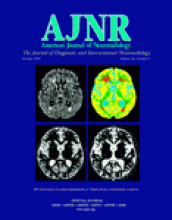Wagner (1) reported on the use of CT fluoroscopy to guide cervical nerve root blocks (CNRB). He detailed the technique and described the initial experience at his institution. He concluded that CT fluoroscopy is a safe and effective alternative during CNRB.
We want to emphasize the serious complications associated with CNRB. Five well-documented cases of catastrophic neurologic complications following CNRB have been reported recently in the literature (2–6). Other publications have alluded to several other unreported cases. Described injuries include brain stem and midbrain hemorrhage, massive cerebellar infarct, occipital cerebral edema, and 2 cases of anterior spinal artery syndrome. Four of the reported patients died as a result of the injuries, and 1 had permanent neurologic sequelae.
The exact mechanism of central nervous system injury following CNRB is not known. In the case reports citing complications following CNRB, a standard technique of radiologic guidance with radiocontrast material and either CT or fluoroscopy was used. A series of mechanisms have been proposed to explain the different neurologic injuries associated with this procedure. One explanation is that CNRB can compromise a radicular artery and jeopardize blood supply to the cervical spinal cord. Possible mechanisms include occlusion by particulate corticosteroids or spasm of the blood vessel. Direct injury of the vertebral artery, embolic microvascular occlusion by corticosteroids, and direct neurotoxicity of radiocontrast agents placed into vertebral intracranial circulation have been proposed to explain injury to more proximal central nervous system structures.
Cervical radicular pain is a common problem that is estimated to occur in 1 of 1000 people per year. Recently, CNRB has gained increased acceptance in the treatment of cervical radicular pain. However, use of CNRB for radicular pain has been advocated on the basis of only observational studies. Although good results have been claimed, this treatment has not been subjected to rigorous controlled studies. Furthermore, CNRB has not been proven to change the natural history of cervical radiculopathy or any other disorder associated with chronic spinal pain.
Given the increased recognition of serious complications and the scarce evidence supporting the effectiveness of CNRB, it is imperative for clinicians to examine the safety and efficacy of this procedure and evaluate potentially safer forms of treatment. An objective assessment of the risks and benefits of CNRB needs to be performed before continued performance of this procedure can be justified. Although many practitioners consider the risk of spinal cord injury and stroke extremely small, the exact incidence and mechanism of injury during CNRB are not known. There is an urgent need to determine the incidence of severe complications, the circumstances associated with such complications, and assess the safest manner to perform CNRB. Only then will we be able to state with confidence that this is a safe and effective procedure.
- Copyright © American Society of Neuroradiology












